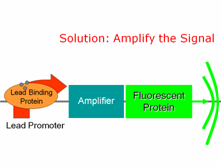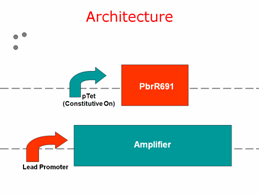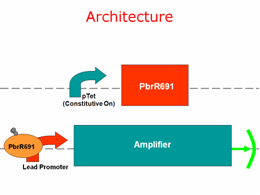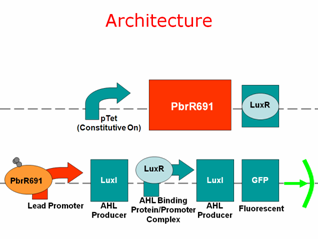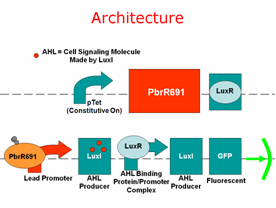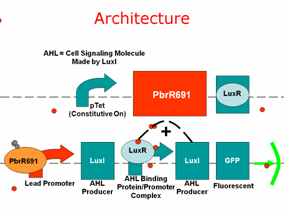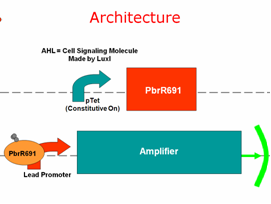\Design
From 2007.igem.org
(Difference between revisions)
| Line 108: | Line 108: | ||
So how does the amplifier work? Well, notice the diagram below: | So how does the amplifier work? Well, notice the diagram below: | ||
| - | [[Image:architecture1.png | + | [[Image:architecture1.png]] |
| + | |||
| + | |||
The orange parts are new parts that we have added to the registry: (a) The gene for the lead binding protein and (b) The lead promoter. The blue parts are existing parts in the registry. | The orange parts are new parts that we have added to the registry: (a) The gene for the lead binding protein and (b) The lead promoter. The blue parts are existing parts in the registry. | ||
The lead binding protein, PbrR691, is under control of a constitutive promoter pTet. This means that PbrR691 is always expressed, and a constant baseline amount of lead binding protein is always present in the cell, ready to go. | The lead binding protein, PbrR691, is under control of a constitutive promoter pTet. This means that PbrR691 is always expressed, and a constant baseline amount of lead binding protein is always present in the cell, ready to go. | ||
The lead promoter is placed before the amplifier part, which is placed before GFP. | The lead promoter is placed before the amplifier part, which is placed before GFP. | ||
| - | [[Image:Architecture2.png | + | [[Image:Architecture2.png]] |
| + | |||
| + | |||
PbrR691 is constantly made at a baseline level under pTet control. It binds to lead that enters the cell, which activates the lead promoter. The signal activates our amplifier and gives us GFP output. | PbrR691 is constantly made at a baseline level under pTet control. It binds to lead that enters the cell, which activates the lead promoter. The signal activates our amplifier and gives us GFP output. | ||
How does the amplifier actually work? Well, let’s remove the black box for a minute. | How does the amplifier actually work? Well, let’s remove the black box for a minute. | ||
| - | [[Image:Architecture3.png | + | [[Image:Architecture3.png]] |
| + | |||
| + | |||
There are two amplification methods here: | There are two amplification methods here: | ||
(a) A positive feedback loop | (a) A positive feedback loop | ||
Revision as of 01:38, 27 October 2007

